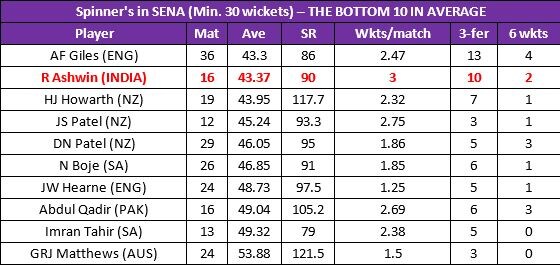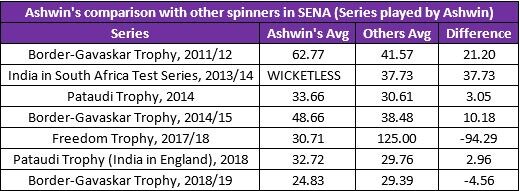
(AP)
Loading...
Having failed to clear a fitness Test, Ravichandran Ashwin was forced to sit out of the final Test at Sydney, ending his participation in the series. After a match haul of six wickets in the first Test at Adelaide, that made a key contribution to India’s win, Ashwin picked up a side strain and was unable to play any further part in the series as a result.
There is no doubt that Ashwin has already done enough in his 65-match career to merit a place amongst the all-time great spinners in Test history. With an aggregate of 342 wickets, he is the seventh-highest wicket-taker amongst spinners in Test cricket.
His bowling average of 25.43 is just marginally higher than Warne’s and amongst the top 10 for all spinners who have at least picked 100 wickets and made their debut after the start of the 20th century. His bowling strike rate of 53.7 is the fourth-best for any spinner (min. 100 wickets) in Test history.
Ashwin’s record in India is amongst the greatest for any spinner in Home conditions – 234 wickets in 38 Tests at 22.68 apiece. His strike rate of 49.2 is the best amongst the 39 spinners who have picked at least 75 wickets at home. Ashwin, on an average, has picked 3.16 wickets in every innings in India. Only Muralitharan fares better picking 3.68 wickets per innings in Sri Lanka.
Ashwin has a stellar record in other subcontinent nations too - Bangladesh (average 19) and Sri Lanka (21.57). Even in the Caribbean, where conditions are similar to Asia, he averages 23.17.
Thus, in helpful conditions on the slow and low spinner-friendly tracks, Ashwin is amongst the greatest bowlers to have ever played the game.
However, what about in conditions not typically suited to spin bowling? How is Ashwin’s record in South Africa, England, New Zealand and Australia (SENA), where there is pace and bounce and where the pitches don’t necessarily crumble on Day 4 and Day 5? With the series in Australia now over for him, it is a good time to examine his outcomes in these conditions.
AMONGST THE WORST IN SENA
Ashwin has picked 48 wickets in 16 Tests in SENA at an average of 43.37 and strike rate of 90. He has no fifer or ten wicket haul in these countries. He has just three ‘4-wickets in an innings’ in 27 outings. Amongst all the 170 spinners who have at least taken 15 wickets in these countries, Ashwin’s average places him at Number 142. His strike rate ranks at Number 120 – that is far from an impressive record in these conditions.
Amongst the 32 sub-continent spinners, who aggregate a minimum of 15 wickets in SENA, Ashwin’s average places him at Number 26. His strike rate ranks at 23.

Ashwin’s average places him amongst the bottom-10 if we restrict the analysis to a minimum of 30 wickets in SENA. It is interesting that Qadir is the only other spinner from the sub-continent in this list.

Ashwin has picked 27 wickets (average 48.07, strike rate 94.7) in 7 Tests in Australia, 14 wickets (32.92, 75) in 6 Tests in England and 7 wickets (46.14, 101.5) in 3 Tests in South Africa.
Ashwin has played 7 series in SENA. He picked 9 wickets in 5 innings at 62.77 apiece in Australia in 2011, went wicket-less in South Africa in 2013, 3 wickets in 2 innings at 33.66 apiece in England in 2014, 12 wickets in 5 innings at 48.66 in Australia in 2014, 7 wickets in 4 innings at 30.71 in South Africa in 2018, 11 wickets in 7 innings at 32.72 apiece in England in 2018 and 6 wickets in 2 innings at 24.83 in Australia in 2018.
Ashwin was well-below the standard average (of other spinners) in 5 out of these 7 series in SENA. This is another indicator that he is falling behind competition in SENA.

WORST STRIKE RATE AMONGST LEADING SPINNERS IN SENA
Ashwin has the worst strike rate amongst all leading spinners (min. 15 wickets) in SENA since his debut (6th November, 2011) – an indicator of his poor wicket-taking prowess in these conditions.
His average places him in the bottom-5 while a product of his average and strike rate place him third-last, only better than Mark Craig and Yasir Shah.
This suggests that he has struggled as India’s leading spinner in SENA and failed to provide adequate support to the pace-unit.
Though Jadeja too does not have an impressive record in SENA, his average and strike rate is marginally better than Ashwin’s. His most recent exploits were impressive picking 7 at The Oval and 5 in Melbourne.

Ashwin has not picked a fifer since August, 2017. Yes, India has played a lot of cricket in SENA in this time-period, but there have been enough opportunities at home where Ashwin has fallen short – fallen short of his own high standards.
While Ashwin will continue to lead the Indian attack at home, with the World Test Championship also scheduled to start from July this year, will India look to Jadeja or Kuldeep as the lead spinner to support the pace-unit in SENA? Or will they give Ashwin another chance to redeem his average returns in these countries?
Time will tell.
First Published: January 4, 2019, 8:41 AM IST


 GET APP
GET APP
 CricViz Analysis: What Makes Bumrah so Good?
CricViz Analysis: What Makes Bumrah so Good? Ganguly Raises Concerns Over Ashwin's Frequent Injuries
Ganguly Raises Concerns Over Ashwin's Frequent Injuries Waugh Empathises With Australia After Poor 12 Months
Waugh Empathises With Australia After Poor 12 Months




